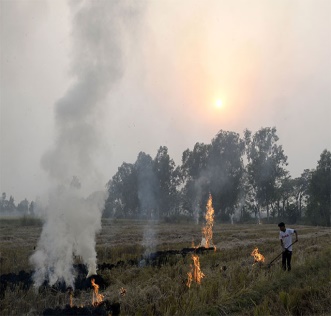On Saturday 10th December, 2017, Mumbai and other neighbouring cities witnessed an unusual fog cover, which had led to low visibility on roads. But Mumbai is lucky on two counts, namely, it has vast sea shore and Arabian Sea by its side and is not subject to pollution because of stubble burning. The fog in Mumbai, as per Indian Meteorological Department, was a passing phenomenon, following cyclone Ockhi. However Delhi is not so lucky. Be it Whatsapp or Social media. Once hiding Kejriwal jokes are back with a bang. Not because he has uttered any line on the PM, but because his party’s controlled Delhi is facing a daunting task for very poor air quality that has led to many respiratory and other diseases. And year on year the problem has arose because of its neighboring states namely Punjab and Haryana. Stubble burning is an age-old practice in Haryana and Punjab. Official sources claim it has been curbed recently through regulations, bans, penalties and surveillance. Recent satellite imageries from Nasa’s Global Fire Mapper, however, reveal that stubble burning is no longer restricted to the rice bowl region but has spread across Madhya Pradesh, Uttar Pradesh, Chhattisgarh, Bihar and Odisha, making things even worse. Among other factors, it has been the burning of stubble in neighboring states that has left Delhi-National Capital Region (NCR) crippled with unprecedented levels of air pollution.
Ironically, stubble burning worsens agricultural production. Burning paddy straw results in massive nutrient losses, some estimates pointing to a loss of about 1.5 lakh tonnes of nutrients annually. Such losses effectively raise expenses made for fertilisers for the following season. Straw carbon, nitrogen and sulphur are completely lost into the atmosphere when burned.
Why are stubble burnt – Reasons
- Cheap alternative to labour cost.
- Burning helps to clear the waste fast in flames.
- Replacement of machine harvest in place manual harvest has led to chopped off stubble which cannot be used as cattle feed or cardboard industry and therefore no economic value.
Alternatives to burning
- Ploughing the stubbles back into the substrate which will boost soil fertility. However it is time-consuming. Machines can be of help but it is an expensive option with little government subsidies.
- Recycling the stubbles into composts and offers monetary benefits
- Use in biogas production.
NPowersU Expert Opinion
Stubble burning is not only polluting environment in and around Delhi, it also affecting air and soil of the agri-rich neighbouring states. There are various entrepreneurs who have devised alternative remedies wherein the government foots in the subsidy bill of the effluent treatment plant and farmers will gain from the monetary benefits from these plants without further damaging the environment. ’Polycrack technology – Waste to energy plant’ is one such example. Let’s see if these States Women go in for Clean shaven agri men or stubble burning men. Let the burning ‘Rest in Piece’.
Related Link:
http://epaper2.mid-day.com/epaper/10-dec-2017-252-edition-Mumbai-Page-1.html

